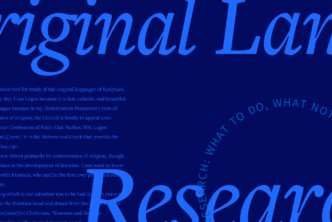You just decided to read Paul’s epistles. Great choice! They are filled with deep theology, pertinent pastoral advice, and valuable instruction for Christian living.
However, you may face some difficulties. At least Peter thought so. He commented—within inspired Scripture—that “[Paul’s] letters contain some things that are hard to understand” (2 Pet 3:16). If the earliest Christians, including personal disciples of Jesus Christ, had trouble understanding Paul’s letters, then we will have struggles too. But studying Paul’s epistles is worth the difficulty. Here are three tips that will help you to study Paul’s New Testament letters.
If the earliest Christians had trouble understanding Paul’s letters, then we will have struggles too.
Tip 1: Orient yourself
The New Testament contains thirteen Pauline epistles, and none of them were written to you—not directly. They were written nearly 2,000 years ago to specific audiences, with particular problems, and for definite purposes. But because of the wisdom of the God who inspired these letters, they contain “teaching, rebuking, correcting and training in righteousness” (2 Tim 3:16) that are essential to your spiritual growth.
In order for you to understand one of Paul’s epistles, therefore, you must first orient yourself by learning about its audience, purpose, and context. Here are some questions that you should ask:
- Who was Paul writing to?
- When and why was Paul writing?
- What was Paul writing about?
If you are able to answer these simple questions before you start reading, you will avoid a lot of confusion. You can find the answers to these questions in various places, but I would suggest that you use a Bible handbook (perhaps the Holman Bible Handbook) or a study Bible (such as the Faithlife Study Bible).
Tip 2: Read epistles like letters
Paul’s epistles are letters, though they are semi-public letters. You should read them accordingly. This seems like obvious and unnecessary advice, but many Christians are still unaware of this simple point. Instead, they read Paul’s epistles like a reference book, picking and choosing verses that suit their needs—or like a novel, reading one chapter at a time. These methods will still bring truth to Bible readers, but those readers will also miss some valuable truth.
So, how do you read an epistle like a (semi-public) letter? I use a simple, two-step reading strategy:
- First, I read the letter as a whole—or at least in large sections if it is a very long letter.
- Second, I go back and reread specific sections that were not clear the first time through.
Paul tended to make long and complex arguments in which one idea or point builds on another. By reading the entire epistle (or at least multiple chapters, if time is short) in one sitting, you will be able to see the overall argument or point that Paul was making. Once you have gained the big picture view of the epistle, you can go back and reread the parts that are less clear. You may even want to read some sections multiple times. And make sure you take time to pray and think between readings. Paul himself told Timothy, “Reflect on what I am saying, for the Lord will give you insight” (2 Tim 2:7).
Tip 3: Utilize your resources
After you have oriented yourself and carefully read a particular epistle, you will almost certainly find that some passages just don’t make sense. That’s okay. You are not alone. Christians have been struggling with some Pauline passages for nearly 2,000 years. As a result, there are numerous books and other resources that can help you to understand difficult passages in Paul’s epistles. The most helpful resource when dealing with a difficult passage is often a commentary.
Commentaries provide section-by-section explanations that can be very helpful when facing difficult passages. When studying a particular epistle, you should use multiple commentaries so you can gain various opinions—and explore supporting arguments—on a difficult passage.
Where should you start?
If you follow the three tips listed above, you could start with any of the epistles. However, Philippians or Titus would be the easiest books for beginners. They are short, straightforward, and practical. Regardless of where you start, studying Paul’s epistles will be a rewarding endeavor.

***
This article was originally published in the September/October 2021 issue of Bible Study Magazine. Slight adjustments, such as title and subheadings, may be the addition of an editor.
Related articles
- All Roads Lead through Cyril: Neochalcedonianism in the Catenae of Pauline Epistles
- How to Interpret the Bible Correctly: Paul’s Epistle to the Romans
- Paul and the Law: 3 Texts that ‘Set the Record Straight’
Related resources
Pauline Epistles, 9 vols. (Tyndale New Testament Commentary | TNTC)
Regular price: $112.99

Surveying the Pauline Epistles (Learn the Word Bible Survey Series)
Regular price: $7.99
Studies in the Pauline Epistles: Essays in Honor of Douglas J. Moo
Regular price: $49.99





